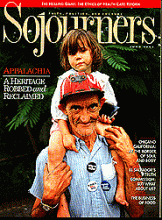Just as food links the body and the soul, it also connects us as individuals with the rest of creation--not only with the soil and sunshine and water from which our food is formed, but with the many human beings whose work has brought it to our tables.
In every direction from Salina, Kansas, the proverbial amber waves of grain stretch to the horizon. A palpable excitement fills the air as farmers at the heart of the nation's breadbasket count down the days to harvest.
In Salina, a town of 42,000, many office workers save their two weeks annual vacation for June, so they can "go home"—which is wherever they have relatives who are still farming—and help bring in the harvest. People who work as secretaries or bank tellers by day will be driving combines and grain trucks long into the summer night. Nearly everyone you meet in Salina either grew up on a farm or has a close relative who did.
Yet even here, and even among farm families, most of the food on people's tables comes from the supermarket. And stores here are stocked with the same brands that fill grocery shelves all over the United States and, increasingly, around the world.
Gone is the Salina hatchery that for years supplied local families who raised chickens for eggs and meat. Gone too is the cheese plant that used to process milk from local dairies. Of the six flour mills that once hummed in this wheat capital, only one remains, and it is owned by a huge multinational corporation.
Read the Full Article

